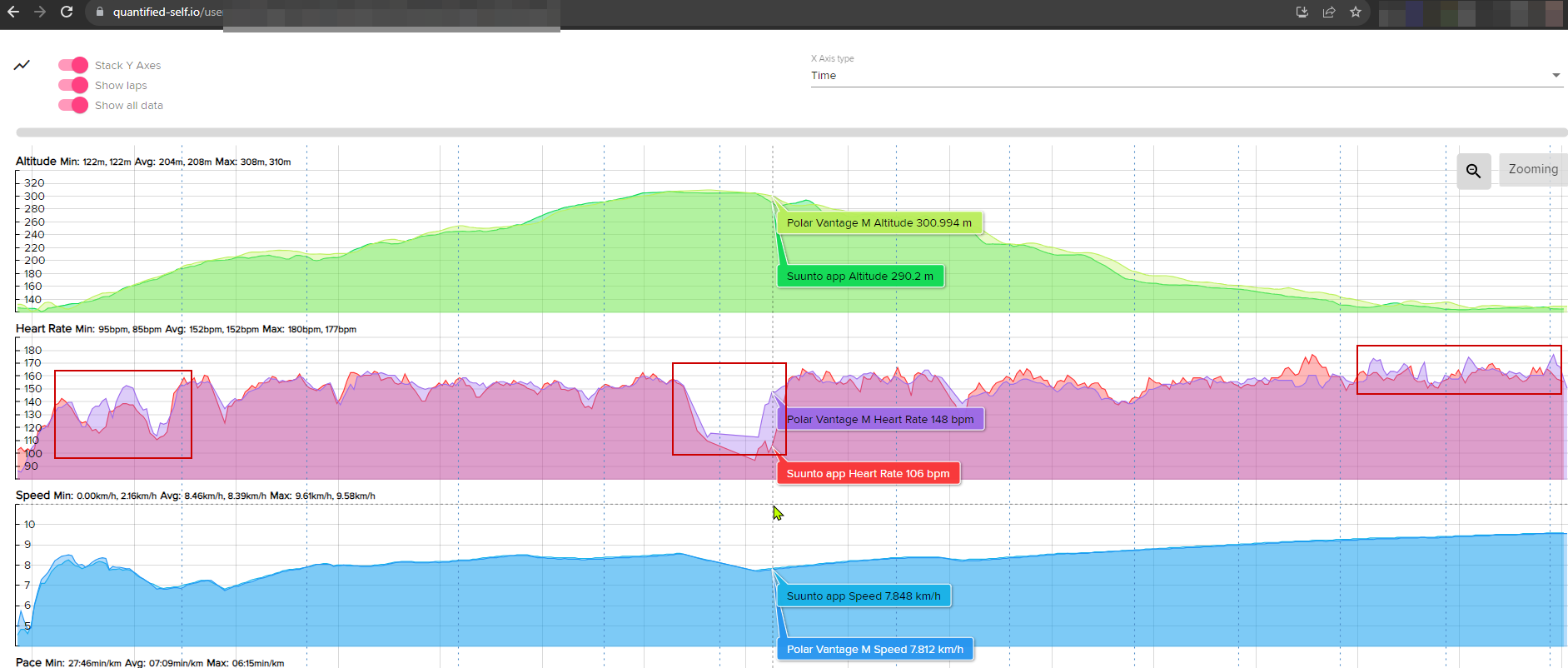HR comparison
-
Opinions on HR accuracy and whether these differences are important vary massively. Some people only look at HR after a session, others use it as part of their load tracking (TSS, TSB), some train by HR rather than pace or power.
If point-in-time HR accuracy is important to you then I’d personally suggest wrist-based HR is never going to be reliable enough for you because small changes in how you wear your watch, how cold it is (changing blood flow just under the skin surface) and how vigorously you are moving your arms etc. will all have an impact. I’d recommend at the very least an arm-based OHR like Polar OH1 or, of course, a chest strap. The other advantages of these on cold days is you can then wear your watch over your long-sleeve top or jacket

If you are using the HR data mostly for TSS or for general guidance on effort after the session, or even just for in-race split/lap style averages to make sure you aren’t pushing too hard too early then I’d say the differences you highlight aren’t really a concern.
-
@laufbursche7 when you say in different parts of the wrist I hope you don’t have both in the same arm, that’s a good starting point to have bad readings. In terms of accuracy of OHR I don’t know,in daily usage is on pair with my Fênix 7 solar, minimum HR, HRV readings etc,in workouts I don’t know because I always use chest strap, even with Garmin Fênix 7 solar or the forerunner 955 , they have great accuracy but sometimes they have flaws,so I use chest strap. With Garmin sometimes when I’m not training for any event in particular on easy or recovery days I leave the chest strap at home and go with the OHR and is ok, with Suunto I never tried, this is my first Suunto watch but I know OHR from Suunto never work well,in any model. If you care with HR,chest strap is the way to go with any sport watch
 enjoy your watch
enjoy your watch -
@tiago of course a watch on each wrist

-
@laufbursche7 No wrist HR that I have used including Apple Watch Ultra, Garmin Epix 2 or Suunto 9PP/Race/Vertical are good enough for training. All are fine for daily/sleep hr monitoring or walking. I would never rely on OHR for assessing my training, including CTL/ATL and TSB.
-
@Brad_Olwin I’ve found the scosche and polar OHR devices, worn high on the arm over the biceps to be accurate for me compared to a belt. They have maybe a second or 2 delay on sudden change such as intervals but as the offset is basically constant there is no impact on calculations for things like TSS and my watch takes longer than a second to react to a change anyhow. They do have to be secure, though - tight enough to leave an indentation after taking them off. Being higher up the arm there’s less chance of movement interference and there’s much more flesh and a better blood supply in the upper arm compared to the wrist or lower arm.
-
@far-blue The batteries on these don’t last long enough for me. Plus, the mountain running I typically do would be a problem for arm placement. Taking clothes on and off I would likely dislodge them.
-
@far-blue said in HR comparison:
I’ve found the scosche and polar OHR devices, worn high on the arm over the biceps to be accurate for me compared to a belt
I’ve tried many times Polar H10 and Polar Verity Sense and unfortunately in many occasions the Verity Sense was not on par with the H10. And I agree w/ @Brad_Olwin, they do not last enough
-
I’m not sure I’d be able to put up with a chest strap for more than a couple of hours but this is why it’s good to have choice in the market
 The Scosche lasts about 20 hours on a charge so I guess if you were running for longer you’d prob. need to have multiple units and swap it out at an aid station while changing gear.
The Scosche lasts about 20 hours on a charge so I guess if you were running for longer you’d prob. need to have multiple units and swap it out at an aid station while changing gear.If only Suunto watches allowed you to pair multiple devices of the same type…
-
@far-blue said in HR comparison:
If only Suunto watches allowed you to pair multiple devices of the same type…
The feature most expected by many of us
-
@far-blue as far as I know to switch from one heart rate monitor to another - during an activity - does not work with Garmin, either. You can easily select the one monitor you want to use before you start the activity. But if the battery is done, Garmin (and others) do not switch to OHR or search for another monitor that has been / could be paired. Please correct me, if this has changed in the last year.
-
@laufbursche7 Sorry for the off-topic, but I’m curious about how you were able to compare two tracks with https://quantified-self.io/
-
@Fabio-Vaccaro Just merge the events, have to be 2 watches worn at the same time.
-
@Brad_Olwin Yeah, two watches at the same time, but how to merge the two traces?
-
@Fabio-Vaccaro Tick the check box for the tracks that you want to merge.
Then click Merge 2 events

-
@babychai Thanks a lot!
